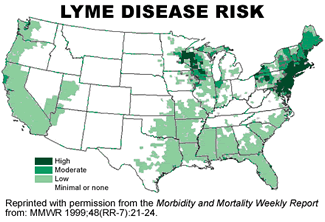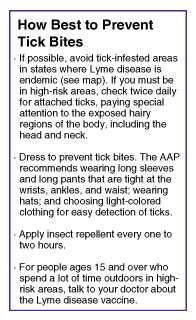New recommendations for preventing Lyme disease
By Rebecca Chastenet de Géry

Back when I spent my summer vacations hiking through forests as a Girl Scout, "tick check" was a regular part of the day. With dusk approaching, we Scouts would amble back into our camp ready to eat, sing, and sleep. But before we were allowed to plop down Indian-style in front of the campfire, troop leader Durant would insist we scrutinize our bodies for ticks. Dutifully, we checked everywhere, from the crevices between our toes to the tops of our sweaty heads, until she was satisfied we'd avoided infestation.
As far as kids and woods go, not much has changed. What has changed is the prevalence of tick-borne Lyme disease, with the number of annually reported cases increasing about 25-fold since surveillance began, in 1982. More than 12,000 cases are reported to the Centers for Disease Control each year. If left untreated, the disease can escalate into heart palpitations, visual disturbances, dizziness, facial paralysis, and eventual neurological disorders. So in an effort to prevent kids from catching Lyme disease altogether -- a risk that peaks from April to September -- the American Academy of Pediatrics (AAP) released a policy statement on the prevention of the disease.

Prevention starts with attention
Transmitted to humans from the bites of deer ticks -- a type of tick found in forested areas, dense grasslands, marshes, gardens, and beach areas -- Lyme disease begins with a small rash at the site of the tick bite. Ninety percent of people also develop a red circular rash that can appear anywhere on the body (not necessarily near the bite). Flu-like symptoms including fever, fatigue, joint stiffness and pain, and headaches may follow.
Given that the disease's early symptoms resemble those of the flu, and that many patients don't even remember the tick bite, diagnosing Lyme disease can be difficult. So if your child has symptoms and you know that he or she has been in a tick-infested area, be sure to inform your doctor of your suspicions.
According to the AAP's recommendations, keeping children away from tick-infested areas in states where the disease is endemic (see map) is the ideal method of prevention. When this is not possible, the AAP recommends protective measures, such as wearing insect repellent and clothing that covers the body well when exposure to ticks is a possibility.
The AAP also recommends performing frequent tick checks, à la troop leader Durant, on children in areas where the disease is endemic. "A tick must be attached to the body for at least 24 hours before Lyme disease can be transmitted," says Dr. James V. Kelsey of the Dartmouth-Hitchcock Clinic, in New Hampshire. "Checking their bodies twice daily for attached ticks should be a very efficient means of preventing the early symptoms of the disease."
Lyme disease vaccine
For children over 15 who spend a lot of time outdoors in high-risk areas, parents may want to consider the new Lyme disease vaccine. Approved by the FDA in December 1998, the vaccination (trade name Lymerix) may provide protection against the disease. "For people who spend a lot of time outdoors in areas where Lyme disease is common, this new vaccine may be a good option," said Dr. Jane E. Henney, FDA commissioner. However, the vaccine does not prevent all cases of Lyme disease and should therefore be considered an adjunct to, not a replacement for, the practice of personal protective measures against tick exposure. "We also want to emphasize that the vaccine is not 100 percent effective, so other precautions should be taken," explains Dr. Henney.
There are potential logistical and financial issues to keep in mind as well. The vaccine's effectiveness depends on the administration of three doses over the course of about a year; the first two doses are administered one month apart, and the third dose is given 12 months after the first dose. The second and third doses should be given before the peak transmission season. Moreover, says Dr. Kelsey, "The vaccine does not confer lifelong immunity, and it's expensive -- $80 a shot." Parents considering the vaccination for their child should talk with their doctor about the child's Lyme-disease risk factors and the cost-effectiveness of the vaccination.
If you find a tick
Even taking careful precautions won't always prevent tick bites. If you see a tick on yourself or your child, remove it carefully:
Grasp the tick's body using fine tweezers held as closely to the skin as possible.
Gently pull the tick straight out. Do not twist it or tug back and forth on it.
Immediately sanitize the area around the bite.
Don't panic. After removing the tick, observe the skin on the entire body. Consult your physician if a suspicious rash and flu-like symptoms develop.
The AAP discourages the practice of routinely prescribing antibiotics for people who have received a tick bite. They also do not recommend administering a blood test for Lyme disease immediately after a person receives a tick bite, since the test often gives false results when performed within a month after infection.
Related link:
The Lyme Disease Network

